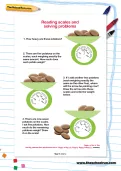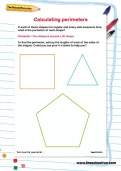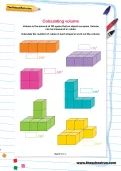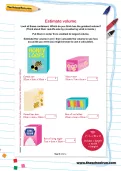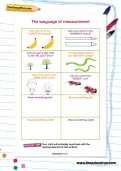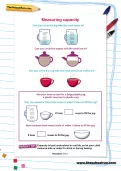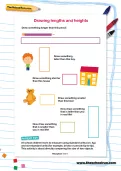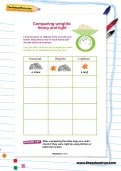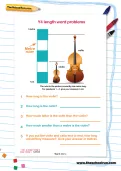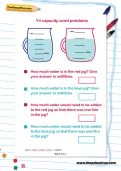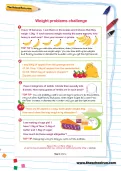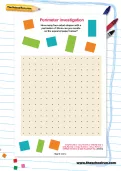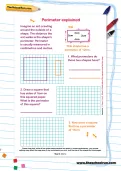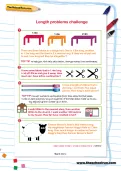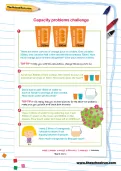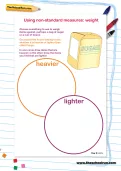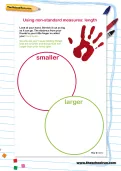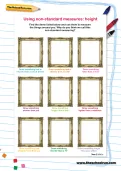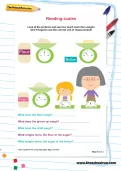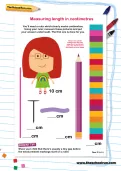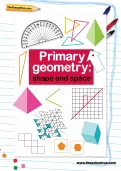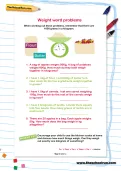Can you find the longest, thinnest, tallest, smallest or widest? Then see if you can draw something long, thin, small and wide.
or
Register to add to your saved resources
Already a subscriber? to view this content.
Can you circle the jug with the most water in? Which teapot has more tea in it? Then get a large plastic jug of water and see if you can work out how many cups of water are in it.
or
Register to add to your saved resources
Already a subscriber? to view this content.
Can you draw something that is longer, shorter, taller or smaller than these objects?
or
Register to add to your saved resources
Already a subscriber? to view this content.
Look for pairs of objects from around your home. Hold them (one in each hand) and decide which is heaviest. Use the table below to show what you have found out.
or
Register to add to your saved resources
Already a subscriber? to view this content.
Can you work out these weight word problems using kilograms and grams? You'll need to remember how many grams are in a kilogram and a half kilogram.
or
Register to add to your saved resources
Already a subscriber? to view this content.
Can you answer these word problems using centimetres and metres?
or
Register to add to your saved resources
Already a subscriber? to view this content.
Can you solve these capacity problems using millilitres and litres?
or
Register to add to your saved resources
Can you solve these weight problems? To help you, you might need to change kg into g.
or
Register to add to your saved resources
Already a subscriber? to view this content.
How many four-sided shapes with a perimeter of 24cm can you create on the squared paper?
or
Register to add to your saved resources
Already a subscriber? to view this content.
Imagine an ant crawling around the outside of a shape. The distance the ant walks is the shape’s perimeter. Perimeter is usually measured in centimetres and metres. Can you work out the answers to these perimeter questions?
or
Register to add to your saved resources
Already a subscriber? to view this content.
To help you with these length calculations, change metres into centimetres and trying drawing the answers.
or
Register to add to your saved resources
Already a subscriber? to view this content.
Can you answer these capacity problem challenges? There are four for you to tackle. You can change the amounts to ml. and draw pictures where it helps.
or
Register to add to your saved resources
Already a subscriber? to view this content.
Let's get weighing! Choose something to use to weigh items against, perhaps a bag of sugar or a can of beans. Go around the house testing to see whether it is heavier or lighter than other things. In one circle draw items that are heavier; in the other draw the items you find that are lighter.
or
Register to add to your saved resources
Already a subscriber? to view this content.
Let's get measuring. Look at your hand. Stretch it out as big as it can go. The distance from your thumb to your little finger is called your hand span. Go around your house finding things that are smaller and things that are larger than your hand span. Write them in these circles.
or
Register to add to your saved resources
Let's have some fun with measuring height. Find the items listed and use them to measure the things around you (for example, draw something that is heavier than a can of beans). Why do you think we call this non-standard measuring?
or
Register to add to your saved resources
Already a subscriber? to view this content.
Look at these pictures and see how much each item weighs. Don’t forget to use the correct unit of measurement!
or
Register to add to your saved resources
Already a subscriber? to view this content.
How good are you at measuring? You’ll need a ruler which clearly marks centimetres. Using your ruler, measure these pictures and put your answer underneath.
or
Register to add to your saved resources
Already a subscriber? to view this content.
Rulers at the ready! Find things around the house for each measurement and fill in the chart.
or
Register to add to your saved resources
Do you know your hexagons from your heptagons, your pentagonal pyramids from your octagonal prisms? From 2D shapes to angles and symmetry our seventy-page Primary Geometry: shape and space learning pack covers all aspects of the national curriculum (Shape and Space) and will ensure your child can use a protractor, translate a shape and look for a mirror line. Challenge them to a game of 3D shape dominoes, make a right-angle measurer and get started!
or
Register to add to your saved resources
Already a subscriber? to view this content.
Can you work out these weight word problems? Remember that there are 1000 grams in a kilogram...
or
Register to add to your saved resources
Already a subscriber? to view this content.

